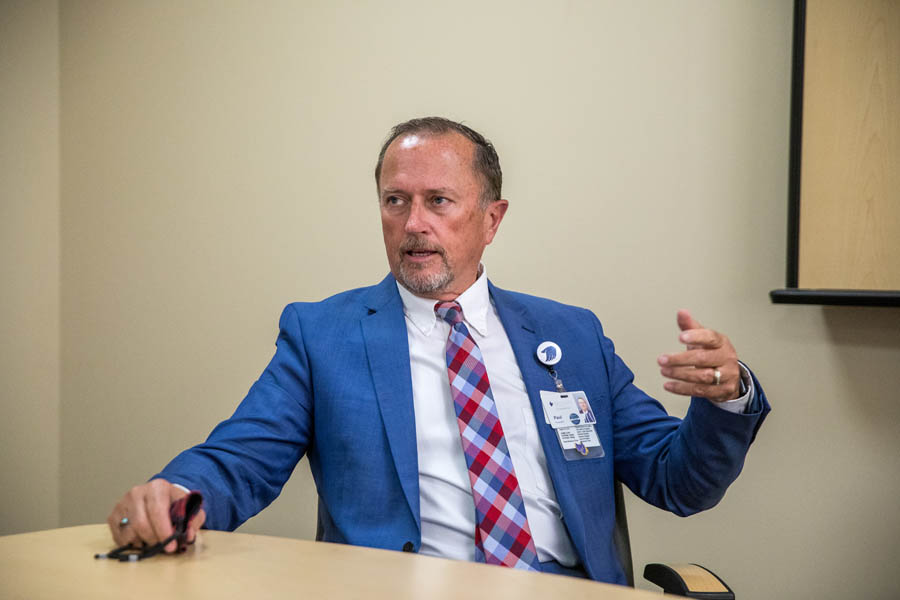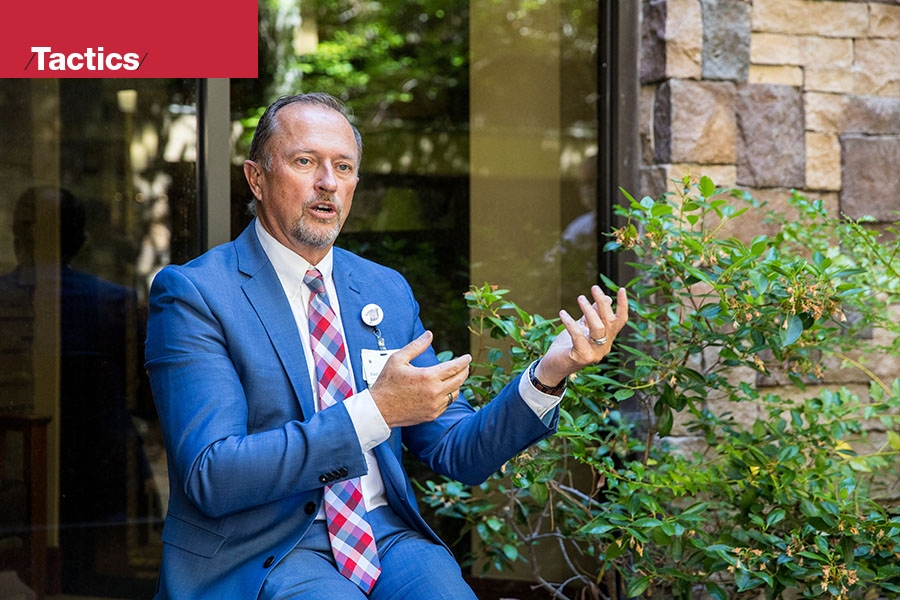The CEO of Sky Lakes Medical Center discusses how the pandemic will impact rural health care.
As the leader of an independent, rural hospital, Paul Stewart, CEO of Sky Lakes Medical Center in Klamath Falls, is dealing with a double whammy of financial pressures: the loss of revenue from cancelled procedures and surgeries, and an above-average and shrinking pool of commercially insured.
In this interview, conducted in early June, Stewart discusses how the pandemic has caused lasting shifts in health care and why many rural hospitals will struggle to remain independent.
This interview has been edited for length and clarity.
 Paul Stewart, CEO of Sky Lakes Medical Center in Klamath Falls Photo by Jason E. Kaplan
Paul Stewart, CEO of Sky Lakes Medical Center in Klamath Falls Photo by Jason E. Kaplan
How has the pandemic affected your hospital financially?
We cut back on a lot of elective procedures and surgeries. While that was the right thing to do, for rural hospitals and hospitals like us that are unaffiliated with another system, it makes us vulnerable. We are the largest employer in our community, so we are sensitive to maintaining employment.
We employ just over 1,500 people and are an important economic engine. We haven’t done mass layoffs or furloughs, but our revenue is down about 30%.
That is an unsustainable equation, obviously. And it is more precarious for us than for urban and suburban facilities, because rural communities tend to have a lower average income. And we probably have quite a bit more people who are on Medicaid.
We are very dependent on a small segment of commercially insured to help balance the finances for the uninsured and Medicaid under-compensation. When elective procedures go away, that is disproportionately commercially insured.
How do you see your role as a smaller, regional hospital evolving in this economic downturn?
Like it or not, we have a big-fish-in-a-small-pond role. Our community and civic leaders expect us and look to us to be engaged in a lot of endeavors in the community. We have a track record of not just being an acute-care hospital.
We are very active in other projects in the community, whether it is housing, social services, services to the disadvantaged, wellness services or parks. Those are harder to do if and when you become financially distressed. There is no direct return on investing our time and energy in those initiatives.
It worries me, coming out of this, that if we are not able to rapidly get back to solid financial footing, then it will have a ripple adverse effect in the entire community as we find ourselves less able to engage in initiatives.
How will the growth of telemedicine impact your business?
The pandemic threw telemedicine about eight years into the future. It has been around for a while, but it has been hard to adopt. Payers have been slow to adequately compensate for it. There have been barriers to the mass implementation of telemedicine.
We implemented telemedicine in a variety of settings, mostly in our primary care settings. It ramped up very quickly and was well utilized.
What would need to happen for you to adopt telemedicine broadly?
The reimbursement either has to go up or providers have to figure out how to do more visits per day. A primary care physician might typically see 13 to 18 patients a day. The reimbursement of a visit depends on the complexity: say it averages $100 per visit.
Telemedicine by comparison averages about $37 for the same visit. To the extent that providers could become more efficient and up the number of patients they see a day, it may still pencil out. But for that to happen, there needs to be better reimbursement.
What will be the biggest long-lasting impact of the pandemic on health care?
We don’t see ourselves going back to what I call a pre-COVID normal. For example, our emergency room visits dropped by 30% overnight. Most likely, a lot of those visits didn’t need to occur there. They probably needed to happen in a primary care provider’s office.
We hope that we don’t fall back into a pattern of relying on the emergency room for primary care. Telemedicine will help supplant that and keep it from falling back.
All hospitals have learned that their disaster plans are not well tooled for this type of a disaster. Our disaster plans were tooled around mass-casualty events or major natural disasters, not for a pandemic.
We were forced into a situation of revamping that plan on the fly through our incident-command structure. What comes out of that are learnings about how to redeploy infrastructure within the organization and outside in the community in a more effective way. For example, we rapidly ramped up getting a quarter of our workforce working from home.
Some of that will stay. To the extent we can continue to monitor productivity and help employees be successful at home, that will alter the landscape for many employers and certainly for health care.
You partnered with Oregon Health & Science University on a new collaborative health care building. What are the advantages of partnering with a large provider?
Included in the vulnerabilities of being independent, small and rural is we don’t have a lot of resources we can turn to. OHSU brings a lot of expertise that we have partnered with since 1992 in the family medicine residency program.
That has been beneficial in augmenting the family medicine manpower supply throughout the state. The hope is to use the learnings from that program in this partnership to expand rural-based training and a host of other disciplines, such as nurse practitioners, pharmacists, behavioral medicine.
We are jointly developing programs that not only benefit rural Oregon but also benefit providers by providing them with exposure to a different type of team-based care that has to happen in rural communities, because we don’t have depth of services.
Many of those providers learn how to operate differently by relying on others more than they would in an urban environment.
With telemedicine growing, do you think you need such large buildings?
The short is answer is no. You probably don’t need as much infrastructure when you don’t have as many people physically coming into the building.
On the other hand, in our community, it provides a great deal of flexibility and future growth capacity that we felt we needed. I think we will put it to good use, but it will be an altered use to what was envisioned.
What is the biggest lesson you have learned from the pandemic in running a health care provider?
It is still really hard to predict the future. This was unprecedented for everyone, especially for health care. It was gratifying to see the entire nation look to our frontline health care providers and our first responders and appreciate the criticality of their role in a different way than a lot of people did before the pandemic.
They were somewhat taken for granted. Of course, the irony is that the industry is arguably the hardest hit. From a rural lens, last year across the country, there were probably 120 rural facilities that shut down. Already it is looking like it will be four times that number this year. There is a lot of vulnerability in the system right now.
Do you think there needs to be more consolidation in the health care sector?
Having been in this business for a long time, I have seen consolidations that work really well at creating stronger organizations and increased capacity and efficiency, and I have seen others that have failed miserably.
Health care doesn’t always react to the same business-like pressures that exist in other capitalistic businesses, if you will. That is especially true in rural environments where local communities take a great sense of ownership in their local hospital.
If you merge with a large metropolitan system that is headquartered in Portland or Seattle, the decisions that are made by those corporate entities don’t always reflect the values and mission of the local community. You can cause unintended adverse consequences.
I suspect there will be more consolidation coming out of this. We are very financially viable. We have spent the last 10 years building our cash reserves and are arguably one of the strongest-rated rural facilities from a financial perspective.
We will be able to sustain our independence coming out of this. Many rural facilities will not be in that position, and they will be forced to consolidate and merge with other organizations. While that is good for their viability, it will entail making decisions for that local community that the community may not like.
To subscribe to Oregon Business, click here.






